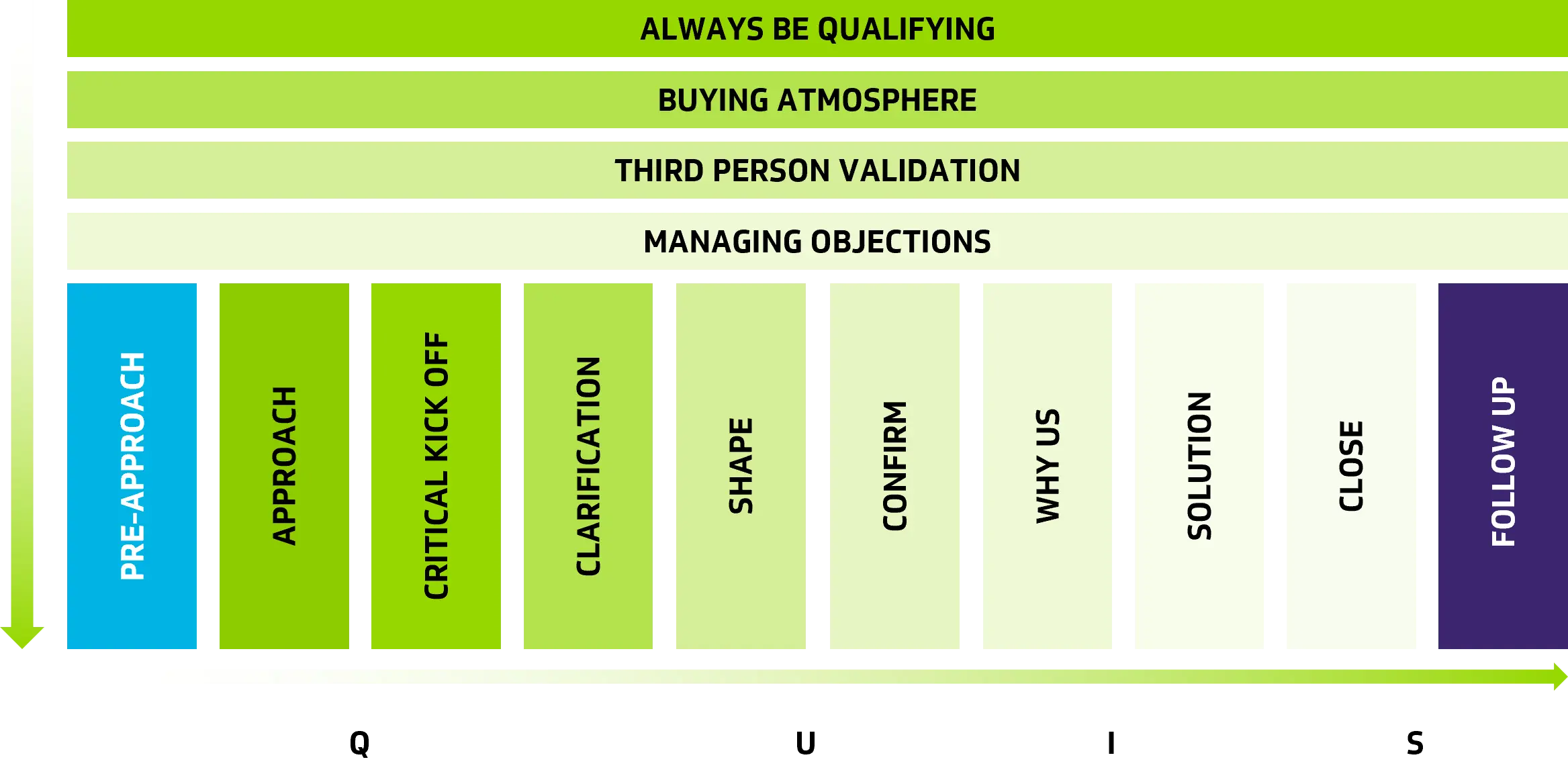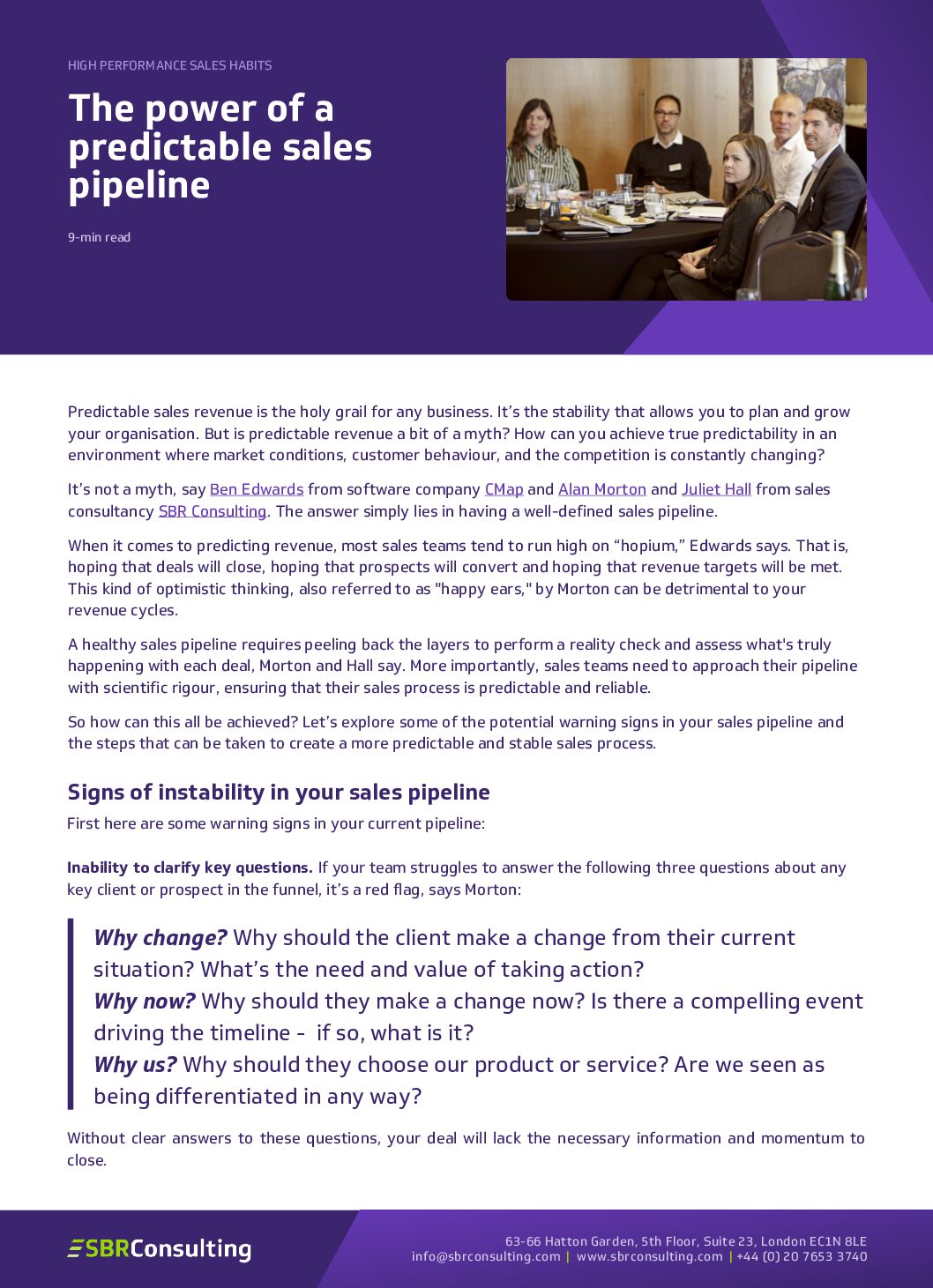
High performance sales habits
The power of a predictable sales
pipeline
9 min read
The power of a predictable sales pipeline
Predictable sales revenue is the holy grail for any business. It’s the stability that allows you to plan and grow your organisation. But is predictable revenue a bit of a myth? How can you achieve true predictability in an environment where market conditions, customer behaviour, and the competition is constantly changing?
It’s not a myth, say Ben Edwards from software company CMap and Alan Morton and Juliet Hall from sales consultancy SBR Consulting. The answer simply lies in having a well-defined sales pipeline.
When it comes to predicting revenue, most sales teams tend to run high on “hopium,” Edwards says. That is, hoping that deals will close, hoping that prospects will convert and hoping that revenue targets will be met. This kind of optimistic thinking, also referred to as “happy ears,” by Morton can be detrimental to your revenue cycles.
A healthy sales pipeline requires peeling back the layers to perform a reality check and assess what’s truly happening with each deal, Morton and Hall say. More importantly, sales teams need to approach their pipeline with scientific rigour, ensuring that their sales process is predictable and reliable.
So how can this all be achieved? Let’s explore some of the potential warning signs in your sales pipeline and the steps that can be taken to create a more predictable and stable sales process.
Signs of instability in your sales pipeline
First here are some warning signs in your current pipeline:
Inability to clarify key questions. If your team struggles to answer the following three questions about any key client or prospect in the funnel, it’s a red flag, says Morton:
Why change? Why should the client make a change from their current situation? What’s the need and value of taking action?
Why now? Why should they make a change now? Is there a compelling event driving the timeline – if so, what is it?
Why us? Why should they choose our product or service? Are we seen as being differentiated in any way?
Without clear answers to these questions, your deal will lack the necessary information and momentum to close.
Having only a single point of contact for a deal. Relying on a single point of contact within a prospect’s organisation is risky. Is their perspective of the wants, needs and context that underpins the deal a personal perspective or reflective of the organisational view? Does that individual have the authority to take unilateral decisions? If that individual leaves the company, gets promoted, or loses interest, the entire deal could fall apart. Multiple points of contact, with a clearly defined main contact or decision maker(s) is key.
How to make your pipeline more predictable
OK, so how can you start to make your pipeline more predictable? Creating a predictable pipeline requires structure, organisation, and data-driven processes.
Examine your forecasting process
Start by examining your current forecasting process. Ask yourself:
Is there a clearly defined process for forecasting?
Is the process well-organised and consistent?
What data do you have to support your forecasts?
“Is there a forecasting process? And is there a qualification methodology?” Morton asks. “If there isn’t, it’s a very unlikely outcome that there would be predictability.”
A thorough and methodical forecasting process ensures that your projections are grounded in reality rather than guesswork.
Implement a qualification methodology
Next, you want to establish a clear set of criteria for qualifying prospects at each stage of the sales process. This takes “instinct” out of the equation. And it goes without saying that clearly defined sales stages are essential for predictability. Everyone on your sales team should understand these stages and what is required to move a prospect from one stage to the next.
“Qualification isn’t a stage or event. It’s an ongoing step in the pipeline process,” Morton says.
As Hall notes, there is a difference to be noted here between sales methodology, sales qualification, and sales forecasting:
Sales methodology refers to the approach your team uses to engage with clients and guide them toward a decision. Whether it’s value-based selling, consultative selling, or another approach, having a consistent sales methodology ensures that all team members are trained in how to skillfully and intentionally interact with prospects and aren’t just “winging it”.
Qualification methodology involves determining whether a prospect is a good fit for your product or service, as well as assessing where you are in the sales process with a particular prospect. What questions do you need to ask at each stage to qualify fit and then to move the client along through the funnel?
Sales forecasting on the other hand, is a distinct process focused on predicting future revenue rather than guiding the sales process itself. It involves predicting the revenue by analysing historical sales data, current pipeline, market trends, and other relevant factors.
There are various types of selling and methodologies, but one SBR uses frequently is The QUIS Sales Methodology, Morton says:
Q – Question:
Ask critical questions to gather the information needed for accurate forecasting. What are the client’s needs, challenges, timelines and decision-making criteria?
U – Understand:
Go beyond the surface level to get a thorough understanding of the client’s context. This includes their pain points, goals and other key context that might influence their buying decisions. It also includes where they are specifically in the buying process – are they just beginning the conversation, or are they already several steps down the road, vetting rival products or suppliers?
I – Influence:
This includes the storytelling and solutioning phase where you want to bring unique solutions and insight to the table, positioning your product or service as the best solution to their challenges.
S – Solidify:
Finally, solidify the relevant next steps to move the deal through the process by addressing any remaining objections and closing the loop on any outstanding issues. Ensure that all stakeholders are aligned and committed to moving forward.

The QUIS methodology is just one approach, but it illustrates the importance of having a structured method in place, Morton says. The takeaway is that whatever method you use, it should be consistently applied and understood across the organisation, data-driven and aligned with your overall sales strategy.
“It’s about process and structure and everybody coming along on that journey and knowing what that looks like and why, because buy-in and adoption has to be there. That’s the magic sauce,” Hall adds.
Have regular pipeline and deal reviews
Finally, regular pipeline and deal reviews are also critical components of maintaining a predictable sales pipeline.
Pipeline reviews should be an integral part of your quarterly, monthly, and weekly sales cadence, so there is a consistent evaluation of pipeline health, identification of risks, and prioritisation of opportunities. This systematic approach enables teams to develop targeted action plans, allocate resources efficiently, and improve forecast accuracy. Ultimately, pipeline reviews keep sales efforts focused on the most promising opportunities, ensuring a more predictable and robust revenue stream.
Deal reviews involve the assessment of specific opportunities. Which deals require a “deep dive” to uncover potential issues or opportunities? Which deals are the most strategic and deserve a little more time and attention? By conducting regular deal reviews, you can ensure that your team is focused on the right deals and not distracted by the overall breadth and girth of the pipeline.
“Also, are the pipeline reviews or deal reviews spent on strategising and innovation or inspecting and summarising?” Juliet adds. “If it’s just about summarising, it can be an onerous task for everybody, but if you can get the team prepared to download quickly, and move swiftly…to strategising, this is where things start to move, and people begin to get engaged.”
Predictable sales revenue is possible
In short, a predictable sales pipeline is not a myth, nor a matter of luck. It’s the result of careful planning, rigorous processes, and disciplined execution. By implementing structured forecasting and qualification processes you can transform your sales pipeline into a reliable and consistent revenue engine. For more information, check out this free webinar, hosted by Ben Edwards of CMAP.
Need help finding predictable revenue in your sales cycle? At SBR Consulting, we partner with your team, mixing our curiosity with insight to create programmes that embed better ways to drive key results:
- Increased sales volume through improved conversion rates.
- Increase sales velocity through improved qualification.
- Increased sales value through larger deal sizes.
- Increased pipeline visibility, predictability and forecast accuracy.
To discover more driving the predictability of your sales pipeline, let’s talk growth.



